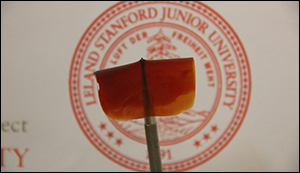Stanford researchers create super stretchy, self-healing material
20. 4. 2016 | Stanford | news.stanford.edu
Researchers show how jolting this material with an electrical field causes it to twitch or pulse in a muscle-like fashion. This polymer can also stretch to 100 times its original length, and even repair itself if punctured.
Artificial muscles currently have applications in some consumer technology and robotics, but they have shortcomings compared to a real bicep. Small holes or defects in the materials currently used to make artificial muscle can rob them of their resilience. Nor are they able to self-repair if punctured or scratched.

But this new material, in addition to being extraordinarily stretchy, has remarkable self-healing characteristics. Damaged polymers typically require a solvent or heat treatment to restore their properties, but the new material showed a remarkable ability to heal itself at room temperature, even if the damaged pieces are aged for days. Indeed, researchers found that it could self-repair at temperatures as low as negative 4 degrees Fahrenheit (-20 C), or about as cold as a commercial walk-in freezer.
The team found that they could tune the polymer to be stretchier or heal faster by varying the amount or type of metal ion included. The version that exceeded the measuring machine’s limits, for example, was created by decreasing the ratio of iron atoms to the polymers and organic molecules in the material.
Read more at Stanford
Image Credit: Bao Research Group
-jk-




